Photo: Taylor Hill/Getty Images for Live Nation Urban)
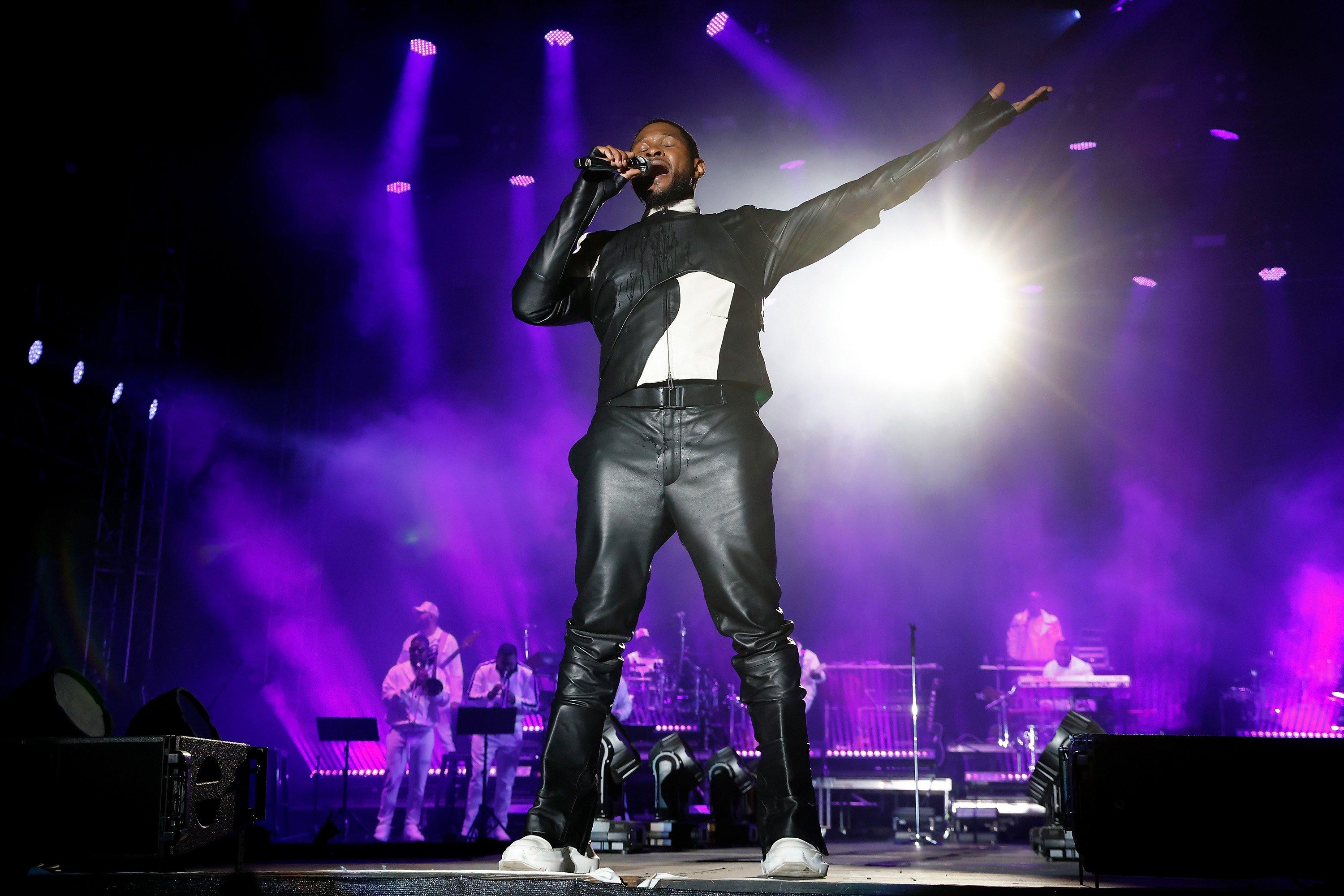
list
8 Exciting Sets From The 2023 Roots Picnic: Usher, Lil Uzi Vert, Lauryn Hill & More
From a surprise reunion of the Fugees, to a special appearance by Eve and Jazmine Sullivan, the 2023 Roots Picnic brought heat and hype across multiple stages. Read on for the festival's most exciting performances.
For 15 years, The Roots have gathered the music’s brightest and fastest-rising talents to perform in Philadelphia for their annual Roots Picnic, and this year’s lineup was nothing short of star-studded.
After kicking off the weekend with Dave Chappelle’s comedy show at the Wells Fargo Center on Friday, the action moved to the Mann Center in Fairmont Park where fans witnessed surprise crew reunions, unexpected cameos, and a taste of the Las Vegas strip across three performance stages.
On Saturday, legendary rap group State Property reunited for the first time in years, Lil Uzi Vert rocked out with the Park Stage crowd for his third picnic appearance. Supported by the Soulquarians, legends the Isley Brothers and Roy Ayers lit up the Park stage. Lauryn Hill closed out day two by commemorating her GRAMMY-winning album, The Miseducation of Lauryn Hill, and bringing out Pras and Wyclef Jean for a Fugees reunion.
Sunday featured high-powered performances from soulful songstress Ari Lennox, former Ruff Ryders first lady Eve, and the devastating femmes of South Florida, the City Girls. Philly’s own DJ Drama drew out home-grown talents like D-Surdy, Armani White, and Bronx legend Fat Joe on the Presser stage.
To close out the weekend, Usher brought the magic of his Vegas residency to West Philly for a string of era-defining hits in the twilight of the festival. Read on for some of the most captivating moments and exciting sets from the 2023 Roots Picnic.
GloRilla Shines In Roots Picnic Debut
GloRilla | Kayla Oaddams/Getty Images
Unapologetic rebel GloRilla may have just one EP under her belt, but her growing fandom came alive during her Roots Picnic performance.
The Presser Stage crowd swooned along with femme-empowering smashes like "Phatnall," as well as more provocative songs like "Nut Quick" and "Lick or Sum." Legions of newly single fans screamed the lyrics to crunk hit "F.N.F. (Let’s Go)."
Big Glo kept the momentum going at high speed, loosening the relatively stiff crowd. And while Cardi B wasn’t present for her part in "Tomorrow 2," GloRilla brought out an energized and visibly pregnant Chrisean Rock for a twerk-worthy cameo.
GloRilla truly embraced her rowdy nature and southern charm, which has helped her earn garner recognition from her peers and even notch her first GRAMMY nod for Best Rap Performance.
Usher Brings Sultry And Sin To The City, With A Few Special Guests
Usher and Black Thought perform | Taylor Hill/Getty Images for Live Nation Urban
Before Usher had even closed out the festival, radio and podcast personality Charlamagne and comedian Jess Hilarious talked about wrapping up their own event early to snag a close seat to watch the R&B star in action.
Though decades into his musical career, Usher hasn't missed a step. Dressed in leather, the eight-time GRAMMY winner delivered his classic, slow-burning album cuts and glossy radio hits under the glimmering lights of the open air Park stage.
Usher put on an electrifying performance that covered hits from various eras in his catalog. Songs like "Love in This Club," "U Don’t Have to Call," and "Lil Freak" had Sunday’s crowd staring in awe, even for those looking to get ahead of the departing traffic. He also brought The Roots on stage before Philly natives Jazmine Sullivan, Eve and Black Thought joined the singer to perform "U Got Me."
Lauryn Hill (And Some Famous Friends) Took The Crowd Way Back
Wyclef Jean, Lauryn Hill, and Pras Michel of the Fugees | Taylor Hill/Getty Images for Live Nation Urban
Lauryn Hill’s reputation precedes her. Some fans joked about her tardiness — or even potential absence — but the legendary vocalist arrived about 30 minutes past her scheduled set time and put on a performance that was met with shockwaves of cheers.
Hill's headlining performance coincides with a big milestone: the 25th anniversary of her groundbreaking album The Miseducation of Lauryn Hill. "Even though it's been 25 years, everything is still everything," she told the enlivened crowd.
She performed tracks from the masterful GRAMMY-winning album, including "Everything Is Everything" and "When It Hurts So Bad," but perhaps the biggest surprise throughout the weekend was the reunion between her, Pras and Wyclef Jean. The trio came together as the Fugees to perform hits "Ready Or Not" and "Killing Me Softly" for a spirited celebration of the group’s 1996 album The Score.
"We’re out here doing 25 years of Miseducation. But there’s another 25 years we didn’t do a couple of years ago because of COVID," Hill said of the group’s project. The group closed out with "Fu-Gee-La," with Hill switching from her soothing alto to her "L-Boogie" persona of old, bringing the joyous crowd to its knees.
City Girls Bring The Twerkers Out To Play
The City Girls brought headliner energy to Sunday’s picnic, with JT and Young Miami inciting a twerkathon with hot summer girl anthems like "Act Up" and "Do It On The Tip" playing out center stage.
The Miami duo kept the energy high with on-stage twerk moves, pulsating hits like "Twerkulator," and efforts to draw out the crowd’s inner act-bad attitude by screaming: "If you’re a bad bitch, say, ‘Hell, yeah!’" And by the end of the group’s performance, fans were left with a racing heartbeat or sweating from the constant flow of high-powered hits and go-get-him-girl records.
Lil Uzi Vert Knows What The City Wants
Lil Uzi Vert | Taylor Hill/Getty Images for Live Nation Urban
Now in their third appearance since 2016, Philly native Lil Uzi Vert took to the Park stage on Saturday, bringing enough bass and adoring screams that could be heard across Fairmont Park.
"I ain’t going to do too much talking. Let’s do it," they said to the roaring crowd. While Lil Uzi’s voice occasionally drowned in a song’s instrumental, their effortless magnetism and signature shoulder roll dance brought excitement to the growing crowd.
The rumblings of hits like "444+222" and "Sauce It Up" rang in fans’ ears, and songs like "Money Longer," and the Diamond-selling smash "XO Tour Llif3" nearly turned portions of the crowd into mosh pits. Lil Uzi’s performance came to a welcomed halt when fans were invited to the stage to dance to the massively popular "Just Wanna Rock," which has become an unofficial anthem in their hometown. "I’m in the city, this they s—." Fans pulled out their phones as the rap star capped off the set with the viral hit.
Lucky Daye Drips In Allure
Only a year removed from his breakthrough album, Candydrip — a genre-drifting and soul-stirring project riddled with pop and R&B hits — Lucky Daye has risen to star status. And with songs like "Real Games" and "Late Night," it’s easy to be drawn to the New Orleans-born artist.
While initially draped in glimmering red garments, it didn’t take the artist long to strip down (well, shirtless, that is), and render impassioned vocals over the cheers and screams of his admirers. He dove into songs across his various albums and fell to his knees to deliver a burningly passionate rendition of "F—kin’ Sound" before the 37-year-old vocalist exited the Mann’s amphitheater stage.
Ari Lennox Conjures Soul In Comforting Fashion
Ari Lennox | Taylor Hill/Getty Images for Live Nation Urban
It’s unclear if Ari Lennox still has plans to step away from the touring circuit for good, but if her Sunday evening performance is any indication, her presence would be sorely missed. The "Shea Butter Baby" vocalist conjured every fragment of her soulful and poetic artistry, bringing vibes despite having a slight cold.
The DC-born R&B singer danced to the flowy breeze setting over the stretched-out crowd while singing favored tracks like "New Apartment," as well as "Waste My Time" and "Pressure" from last year’s Age/Sex/Location. Lennox encouraged fans to close their eyes and sway their hips, and many raised drinks as Lennox’s soothing voice and sultry lyrics wrapped around their bodies.
Busta Rhymes And Eve Come To Devastate
Spliff Star and Busta Rhymes | Taylor Hill/Getty Images for Live Nation Urban
Joined by The Roots’ Black Thought, Busta Rhymes and Spliff Star tore down the Park stage, even with distracting audio woes hindering the early part of their set. Shot mic or not, Busta’s lion-like voice could be heard from yards away as he spewed the lyrics to "Put Your Hands Where My Eyes Could See" and A Tribe Called Quest’s "Scenario" to a cheering audience.
Eve arrived during the latter part of the DJ J. Period curated set. The former First Lady of Ruff Ryder burst onto the stage and held her own alongside the fellow hip-hop heavyweights. As she swayed the crowd with songs like "Tambourine" and her verse on the late DMX’s "Ruff Ryders Anthem (Remix)," it harkened back to her days as a lyrical wild card in the early 2000s before she ventured into acting and hosting gigs.
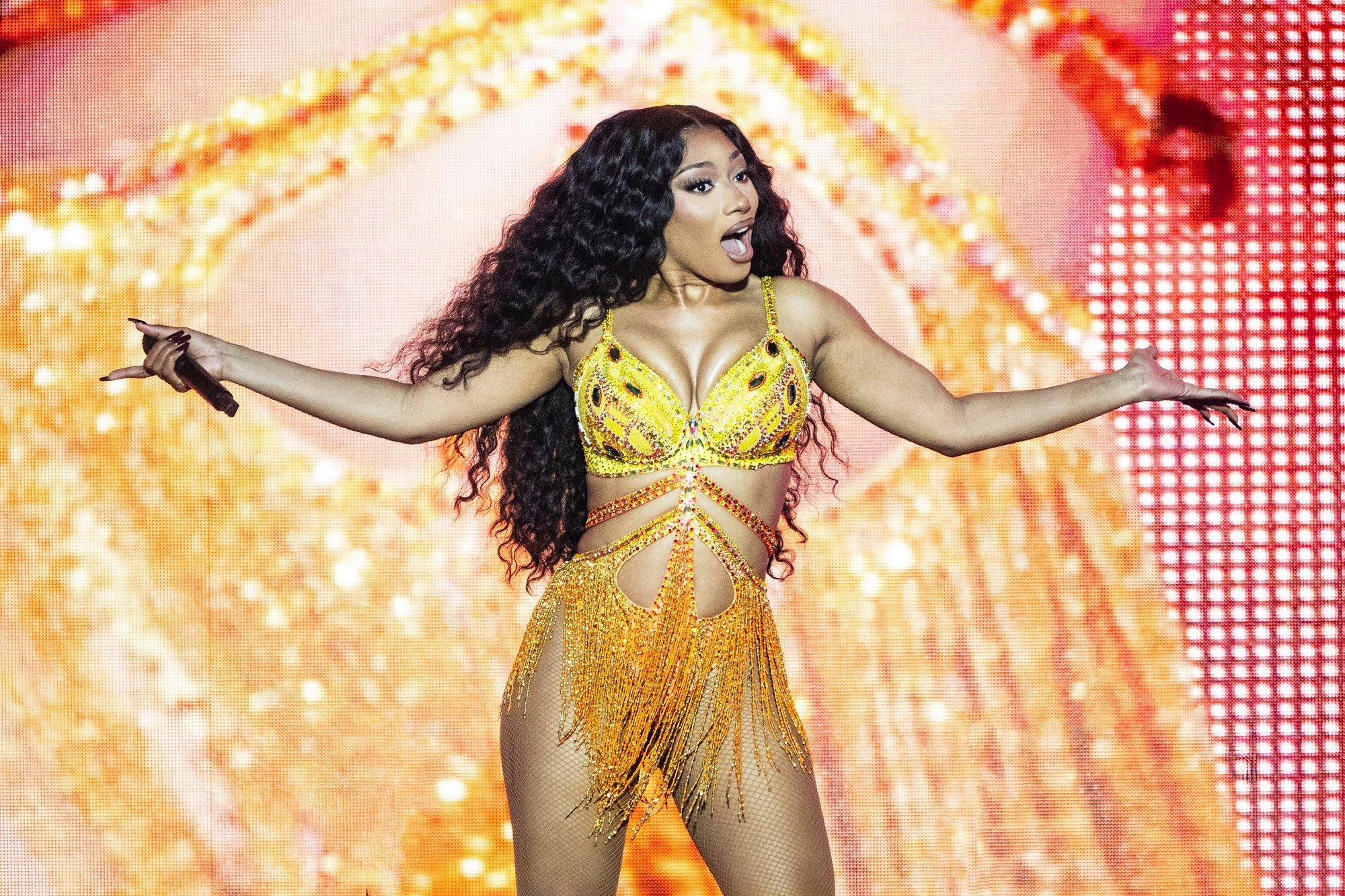
Photo: Erika Goldring/Getty Images
list
6 Takeaways From Megan Thee Stallion's 'Megan': Snakes, Shots & Self-Assurance
From the serpentine theme to Japanese rhyme schemes, Megan Thee Stallion's third album snatches back her own narrative and isn't afraid to take a bite.
Beware of venom: Megan Thee Stallion is not biting her tongue on her new album, simply titled Megan.
The GRAMMY winner's first full-length release in two years is also the first to drop under her own control. Fans have been ready for this release even before the first single, "Cobra," came out in November. The second single, "Hiss," followed in January and brought the star her first No. 1 hit on the Billboard’s Hot 100 and Global 200 charts. These songs, as well as the third single, "BOA," foreshadowed a certain slithery theme that helped shape the album.
Megan was released on June 28 and features guest stars such as GloRilla, Victoria Monét, Big K.R.I.T. and Kyle Richh as well as her longtime ace producers like Juicy J (who made "Hot Girl Summer" among other calling cards) and LilJuMadeDaBeat, who produced Stallion anthems like "Big Ole Freak," "Body" and "Thot S—."
Here’s what we learned from listening and vibing to the latest work by three-time GRAMMY winner Megan Thee Stallion.
A Theme Snakes Through Megan
As could have easily been predicted from the first three singles "Cobra," "Hiss" and "BOA," and now the album track "Rattle," there is a hint of a snake theme that wends its way through the album from beginning ("Hiss") to end ("Cobra").
In several songs, she denounces all the snake behavior that she has encountered from former lovers, friends, and haters who support those who have caused actual harm to her. In the music video for "Cobra," Megan literally sheds her old skin to reveal a shining new layer.
Megan Is Calling The Shots This Time
"I feel like Biggie, 'Who Shot Ya?’/But everybody know who shot me, bitch/ So now, let’s stop speaking on the topic," she rapped in "Who Me (feat. Pooh Shiesty)" off her 2022 album Traumazine. MTS was referencing the July 2020 incident in which rapper Tory Lanez shot her in the foot, and was subsequently charged with assault with a semiautomatic firearm and carrying a loaded, unregistered firearm in a vehicle.
Turns out, she wasn’t done referencing the topic. Now, she’s one taking the shots. MTS takes aim at less-talented women rappers on "Figueroa" (named for a Los Angeles street known for prostitution), and at Lanez on "Rattle," when she suggests that his male supporters should schedule a conjugal visit with him in prison. (Lanez is currently serving a 10-year sentence while simultaneously going through a divorce with wife Raina Chassagne.)
More Megan Thee Stallion News & Videos

6 Takeaways From Megan Thee Stallion's 'Megan': Snakes, Shots & Self-Assurance
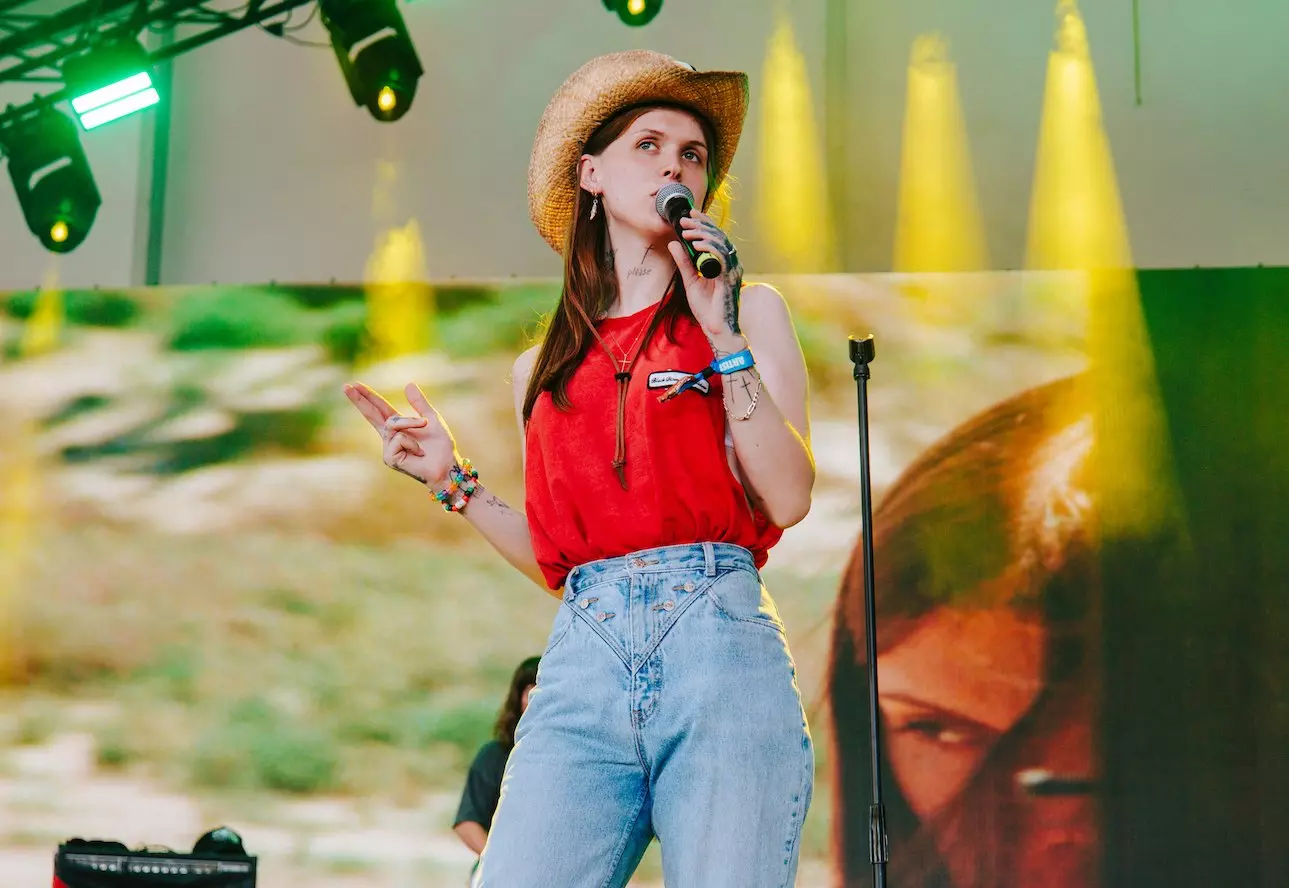
9 Epic Sets From Bonnaroo 2024: Ethel Cain, Melanie Martinez, Megan Thee Stallion & More
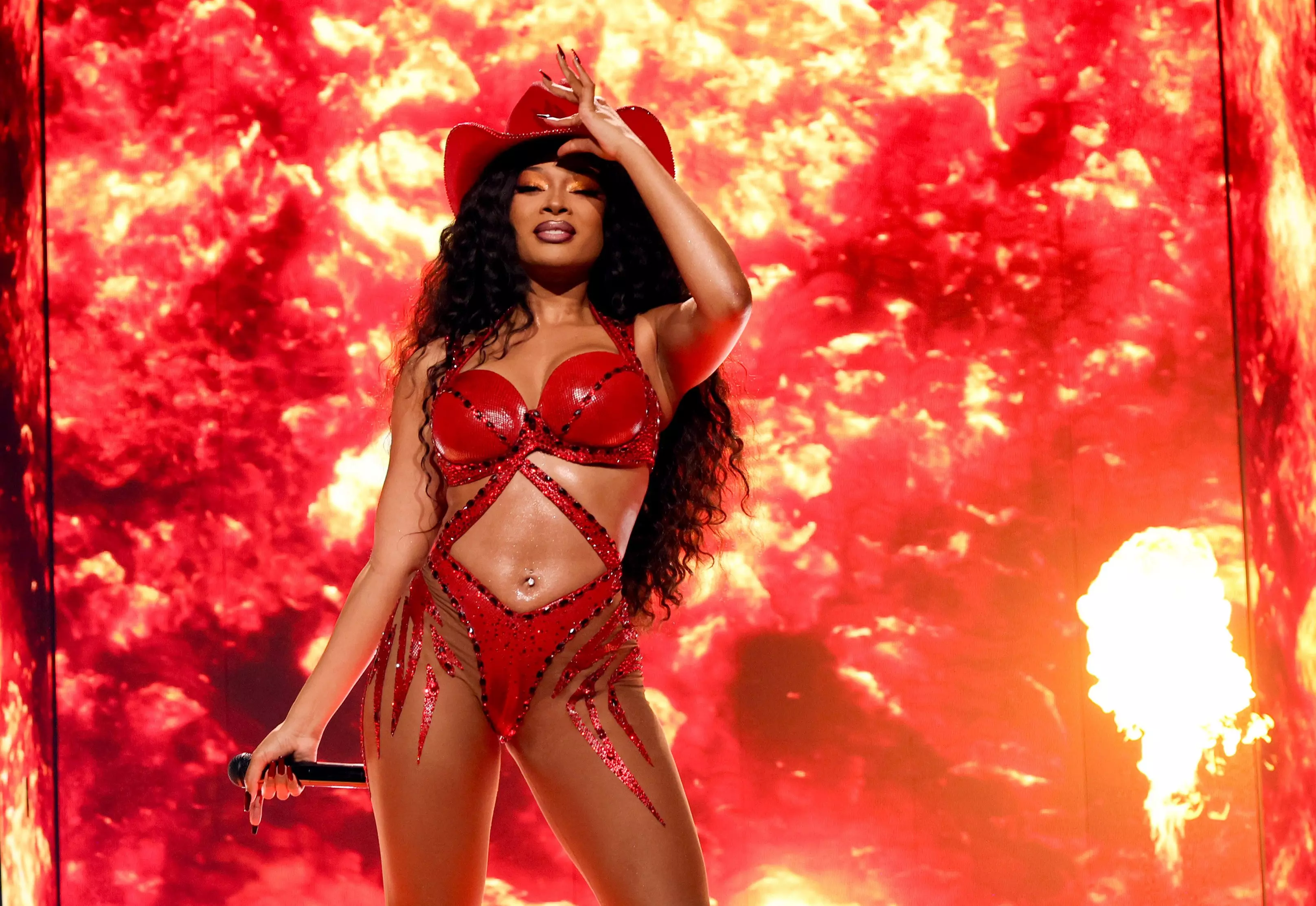
5 Iconic Moments From Megan Thee Stallion's Houston Hometown Shows
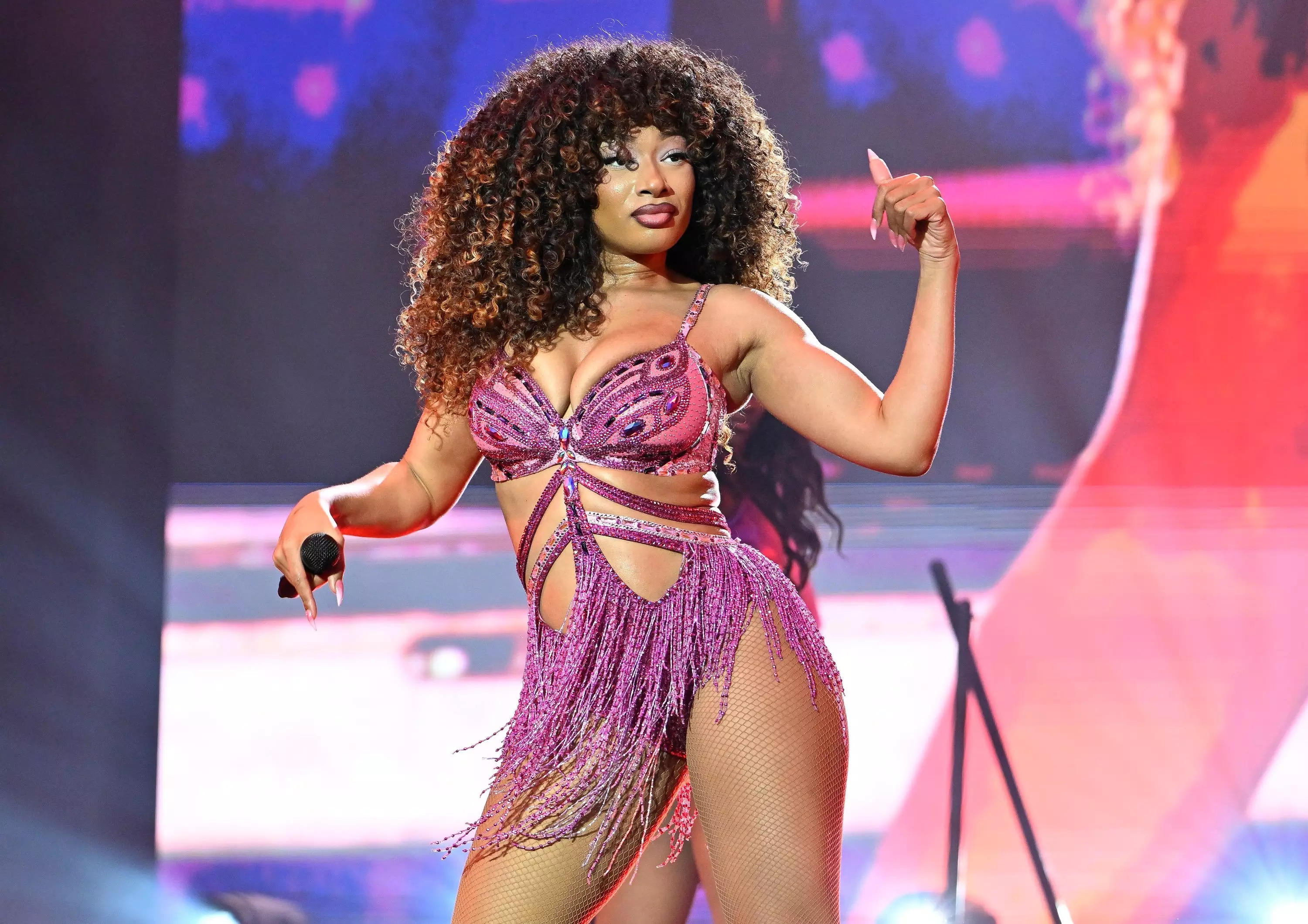
Everything We Know About Megan Thee Stallion's New Album 'Megan': Tracklist, Release Date & More
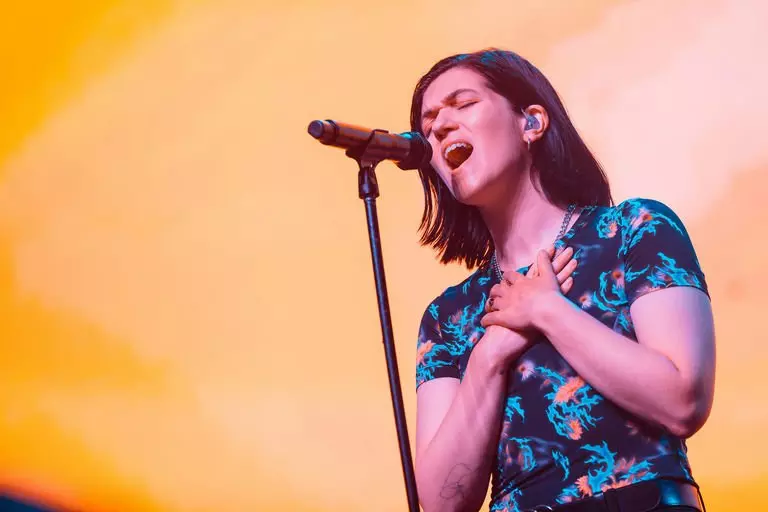
15 LGBTQIA+ Artists Performing At 2024 Summer Festivals
Inspiration Comes From Everywhere
The star and her collaborators incorporate unexpected musical influences on Megan via creative sampling. Megan Thee Stallion speeds up and flips Teena Marie's 1984 ballad "Out on a Limb" for "B.A.S." — a song she co-produced with her longtime ally LilJuMadeDaBeat. "BOA" is cleverly crafted from sounds in the first solo hit by Gwen Stefani, 2004’s "What You Waiting For?"
UGK are reunited from across the heavenly divide on the Juicy J-produced "Paper Together," with Bun B contributing new work and the late Pimp C joining in lyrical spirit. This is especially significant when considering that Juicy J produced "Intl’ Players Anthem (I Choose You)," UGK’s 2007 hit with Outkast. Juicy J also made the beats for Megan’s famous song "Hot Girl Summer."
That’s just the tip of the iceberg when it comes to samples waiting to be discovered on Megan. There are many more riffs and other musical notions that the sample bank in our brains have yet to detect.
Self-Love Is Queen
Whether she’s affirming, "I’m worthy, not worthless" on "Worthy," or literally touching herself in the auto-erotic "Down Stairs DJ" (which joins masturbation masterpieces like Divinyls’ "I Touch Myself" and Tweet’s "Oops"), Megan is grounded in songs that promote self-love as the best kind of love.
She does admit that this is sometimes a challenge to embody, as when she talks about lingering depression on "Moody Girl." But the album generally moves towards the light.
She Loves Japan
One of the big surprises on Megan is that she raps in two languages. She rhymes beautifully in Japanese on "Mamushi" with Yuki Chiba, a seasoned rapper from Japan who is influenced by the Southern swag. (Just take a look at the Memphis moves and Houston rhyme schemes of his viral song "Team Tomodachi.")
On "Otaku Hot Girl," she raps about the manga series "Naruto" and drops other anime references to show her love of Japanese pop culture.
Learn more: 10 Neo J-Pop Artists Breaking The Mold In 2024: Fujii Kaze, Kenshi Yonezu & Others
Megan's Game Is Tight
Megan is the first album to be released on Megan Thee Stallion’s own label. It follows her split from 1501 Certified Entertainment, a record label with which she was engaged in a protracted and ugly legal battle for earnings.
She now has the muscle of the major label Warner Brothers as a partner for her independent venture, Hot Girl Productions. She also recorded an Amazon Original song called "It’s Prime Day" for a commercial, as well as an exclusive Amazon edition of Megan.
It’s safe to say that this album represents a new level of business freedom and acumen for Megan Thee Stallion.
PRIDE & Black Music Month: Celebrating LGBTQIA+ & Black Voices
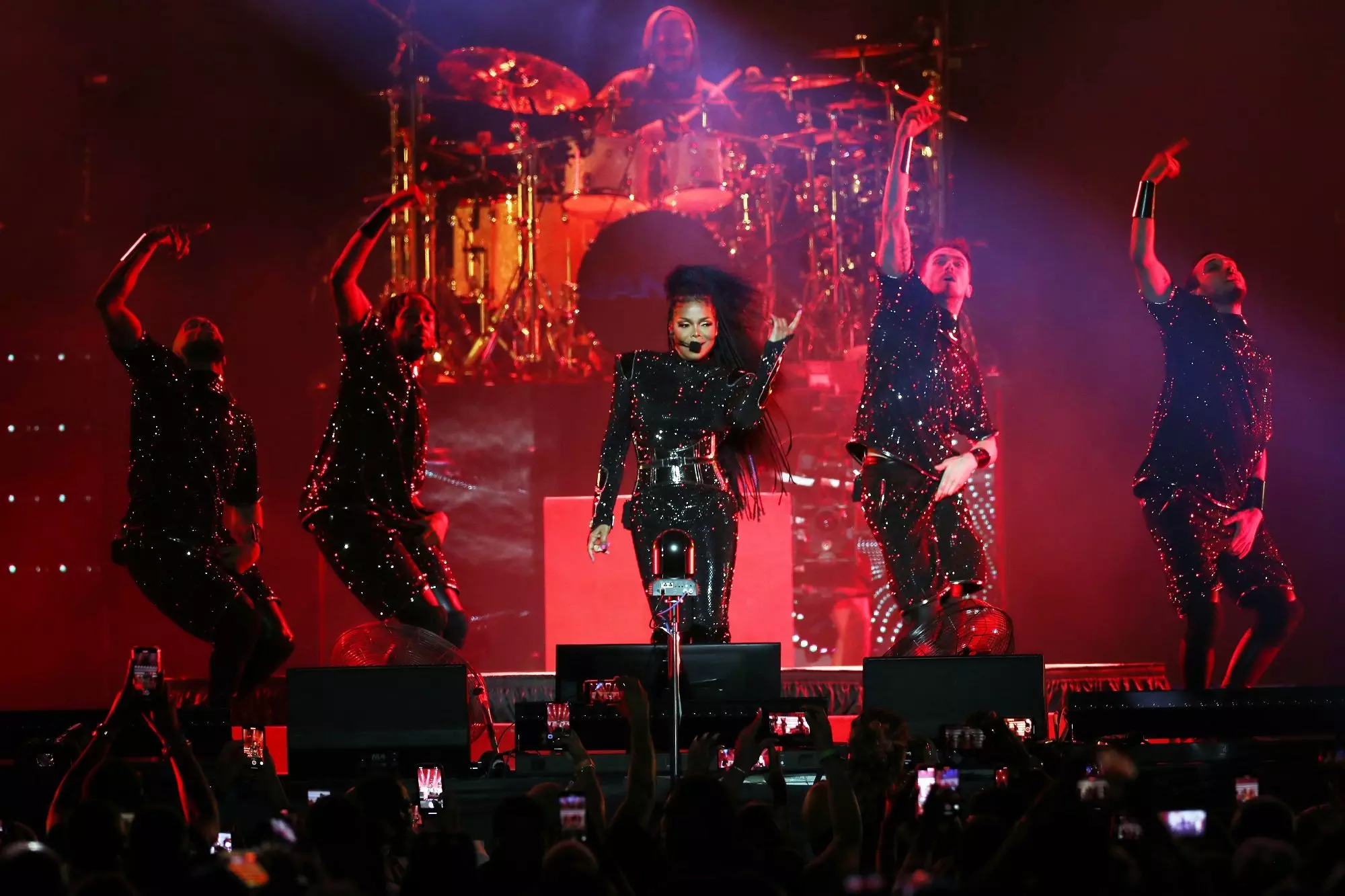
Celebrating 30 Years Of Essence Fest: How New Orleans & Multi-Generational, Diasporic Talent Create The "Super Bowl Of Culture"
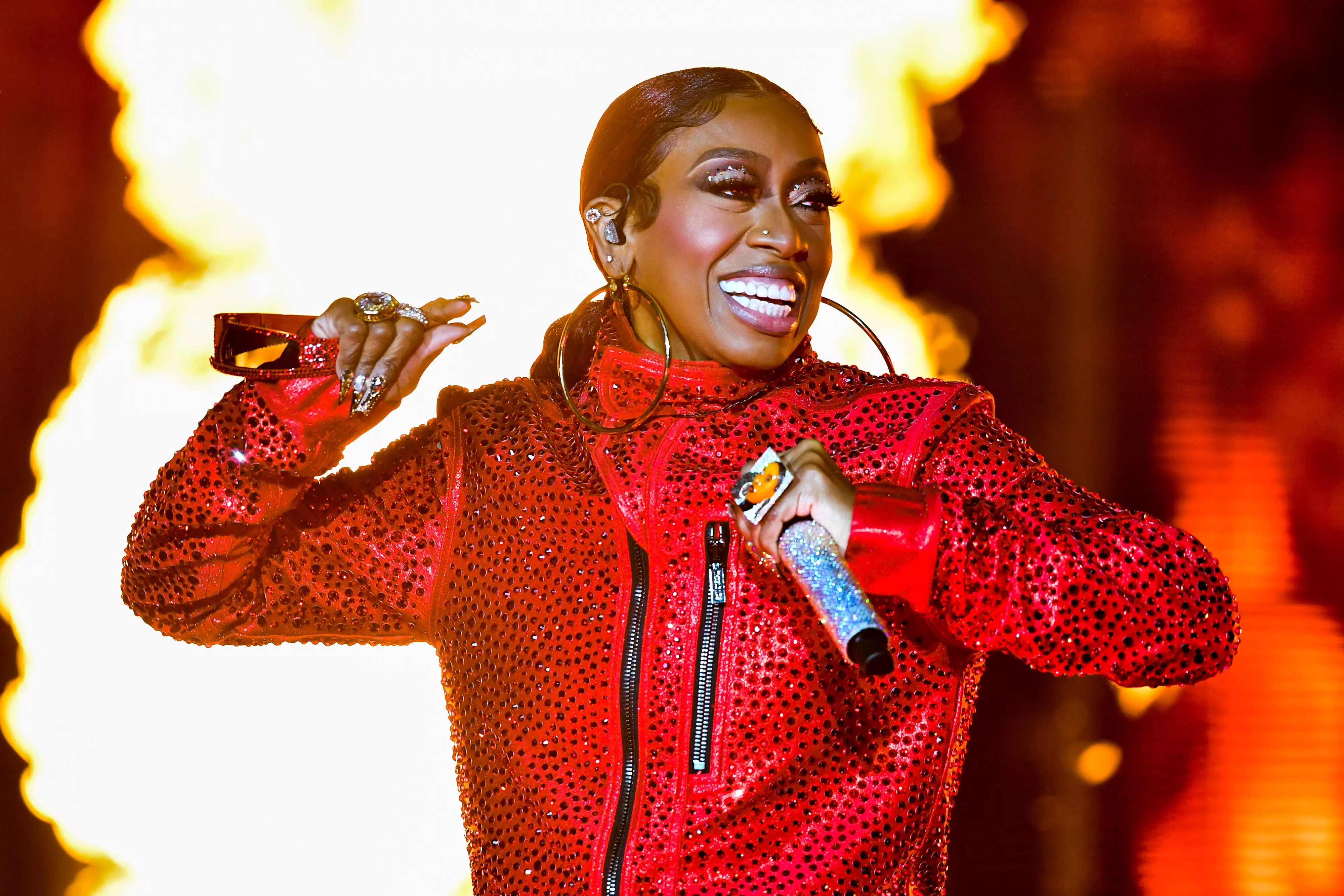
Celebrating Missy Elliott: How The Icon Changed The Sound, Look & Language Of Hip-Hop
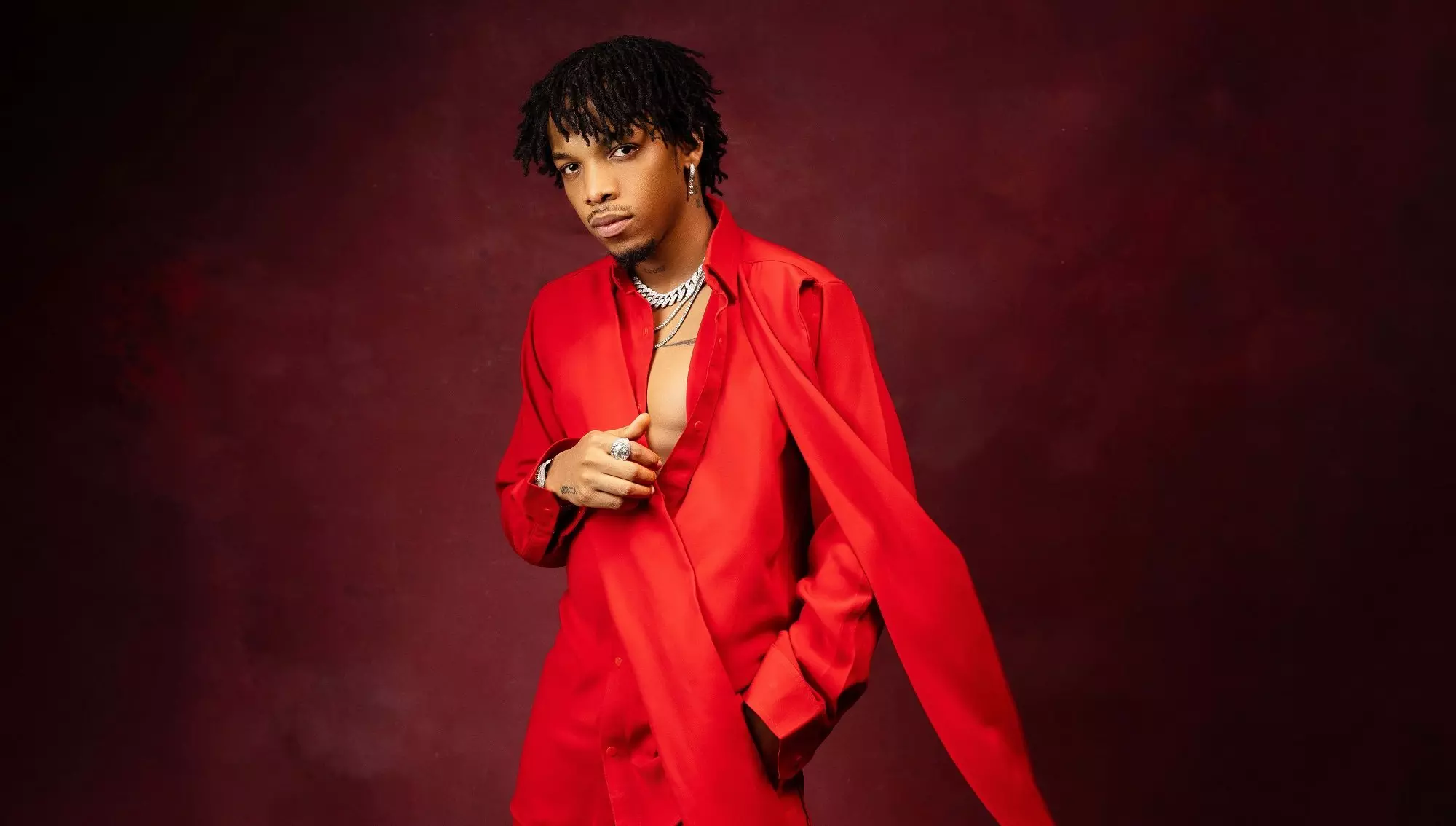
Tekno Talks New Music, Touring America & His "Elden Ring" Obsession

5 LGBTQIA+ Record Labels To Check Out: Get Better Records, So Fierce! And Others
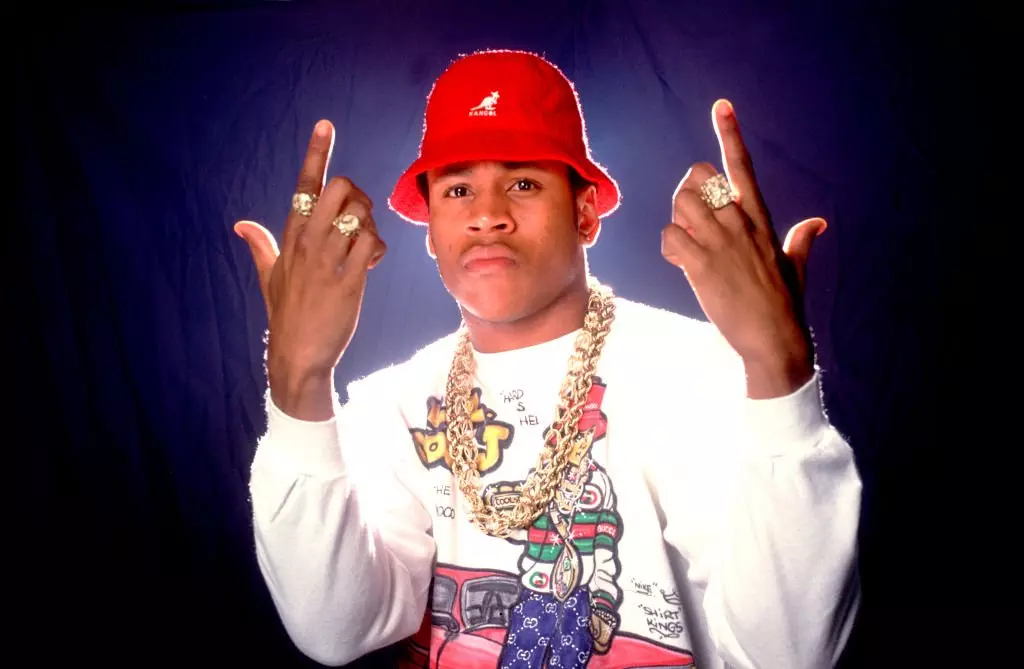
Celebrate 40 Years Of Def Jam With 15 Albums That Show Its Influence & Legacy

Photo: Taylor Hill/Getty Images for Live Nation Urban
list
9 Lively Sets From The 2024 Roots Picnic: Jill Scott, Lil Wayne, Nas, Sexyy Red, & More
From hit-filled sets by The-Dream and Babyface to a star-studded tribute to New Orleans, the 2024 iteration of the Roots Picnic was action-packed. Check out a round-up of some of the most exciting sets here.
As June kicked off over the weekend, The Roots notched another glorious celebration at West Philadelphia's Fairmount Park with the 16th annual Roots Picnic. This year's festival featured even more activations, food vendors, attendees, and lively performances.
On Saturday, June 1, the action was established from the onset. October London and Marsha Ambrosius enlivened the soul of R&B lovers, while Method Man and Redman brought out surprise guests like Chi-town spitter Common and A$AP Ferg for a showstopping outing.
Elsewhere, rappers Smino and Sexyy Red flashed their St. Louis roots and incited fans to twerk through the aisles of the TD Pavilion. And Philly-born Jill Scott's sultry vocals made for a memorable homecoming performance during her headlining set.
The momentum carried over to day two on Sunday, June 2, with rising stars like Shaboozey and N3WYRKLA showing the Roots Picnic crowd why their names have garnered buzz. Later in the day, rapper Wale brought his signature D.C. swag to the Presser Stage. And while Gunna's performance was shorter than planned, it still lit the fire of younger festgoers.
Closing out the weekend was a savory tribute to New Orleans courtesy of The Roots themselves, which also starred Lil Wayne, acclaimed R&B vocalists, an illustrious jazz band, and some beloved NoLa natives.
Read on for some of the most captivating moments and exciting sets from the 2024 Roots Picnic.
The-Dream Serenaded On The Main Stage
The-Dream | Taylor Hill/Getty Images for Live Nation Urban
After years away from the bright lights of solo stardom, The-Dream made a triumphant return to the festival stage on Saturday. The GRAMMY-winning songwriter and producer played his timeless R&B hits like "Falsetto" and "Shawty Is Da S––," reminding fans of his mesmerizing voice and renowned penmanship.
His vocals melted into the sunset overlooking Fairmount Park Saturday evening. And even in moments of audio malfunctions, he was able to conjure the greatness he's displayed as a solo act. Although, it may have looked easier than it was for the Atlanta-born musician: "Oh, y'all testing me," he said jokingly.
The-Dream slowed it down with the moodier Love vs. Money album cut "Fancy," then dug into the pop-funk jam "Fast Car" and the bouncy "Walkin' On The Moon." He takes fans on a ride through his past sexual exploits on the classic "I Luv Your Girl," and closes on a fiery note with the "Rockin' That S—." While even he acknowledged that his set wasn't perfect, it left fans hoping to see more from the artist soon.
Smino Rocked Out With His Philly "Kousins"
Smino | Shaun Llewellyn
Despite somewhat of a "niche" or cult-like following, Smino galvanized music lovers from all corners to the Presser Stage. The St. Louis-bred neo-soul rapper played silky jams like "No L's" and "Pro Freak" from 2022's Luv 4 Rent, then dove into the sultry records from his earlier projects.
"Klink" set the tone for the amplified showcase, with fans dancing in their seats and through the aisles. His day-one fans — or "kousins," as he lovingly refers to them — joined him on songs like the head-bopping "Z4L," and crooned across the amphitheater on the impassioned "I Deserve."
Under Smino's musical guidance, the crowd followed without a hitch anywhere in the performance. It further proved how magnetic the "Netflix & Dusse" artist is live, and how extensive his reach has become since his 2017 debut, blkswn.
Nas Took Fans Down Memory Lane
Nas | Taylor Hill/Getty Images for Live Nation Urban
The New York and Philadelphia connection was undeniable Saturday, as legendary Queensbridge MC Nas forged the two distinctive cities for a performance that harnessed an "Illadelph State of Mind."
The "I Gave You Power" rapper played his first show in Philadelphia as a teenager, when he only had one verse under his belt: Main Source's 1991 song "Live at the BBQ." Back then, Nas admitted to underplaying the city's influence, but he knew then what he knows now — "I had to step my s— up." And he did.
The rapper played iconic songs like "Life's a B–" and "Represent" from his landmark debut Illmatic, which celebrated 30 years back in April. He even brought out Wu-Tang Clan's Ghostface Killah to add to the lyrical onslaught, and played records like "Oochie Wally" and "You Owe Me" to enliven his female fans.
Sexyy Red Incited A Twerk Fest
Sexyy Red | Frankie Vergara
Hot-ticket rapper Sexyy Red arrived on the Presser Stage with a message: "Make America Sexyy Again." And as soon as Madam Sexyy arrived, she ignited a riot throughout the TD Pavilion aisles. Twerkers clung onto friends and grasped nearby railings to dance to strip club joints like "Bow Bow Bow (F My Baby Dad)" and "Hood Rats."
Red matched the energy and BPM-attuned twerks from her fans, which only intensified as her lyrics grew more explicit. Sexyy encouraged all of the antics with a middle finger to the sky, her tongue out, and her daring lyrics filling the air. Songs like "SkeeYee" and "Pound Town" added to the nonstop action, leaving fans in a hot sweat — and with their inner sexyy fully unlocked.
Jill Scott Delivered Some Homegrown Magic
Jill Scott (left) and Tierra Whack | Marcus McDonald
To close out night one, the Roots Picnic crowd congregated at the Park Stage for a glimpse of Philadelphia's native child, Jill Scott. The famed soulstress swooned with her fiery voice and neo-soul classics like "A Long Walk" and "The Way." Fans swayed their hips and sang to the night sky as Scott sprinkled her musical magic.
Scott, wrapped up in warm, sapphire-toned garments, was welcomed to the stage by Philadelphia Mayor Cherelle L. Parker. The newly elected official rallied the audience for a "Philly nostalgic" evening, and the GRAMMY-winning icon delivered a soaring performance that mirrored her vocal hero, Kathleen Battle. "Philadelphia, you have all of my love," Scott gushed. "I'm meant to be here tonight at this Roots Picnic."
"Jilly from Philly" invited some of the city's finest MCs to the stage for the jam session. Black Thought rapped along her side for The Roots' "You Got Me," and Tierra Whack stepped in for the premiere of her and Scott's unreleased rap song, a booming ode to North Philly.
Fantasia & Tasha Cobbs Leonard Brought Electrifying Energy
Fantasia | Taylor Hill/Getty Images for Live Nation Urban
Led by the musical maestro Adam Blackstone, singers Tasha Cobbs Leonard and Fantasia set the warmness of Sunday service and their Southern flare with a "Legacy Experience." And as the title of the performance suggests, their fiery passion was a thread of musical mastery.
As fans danced across the lawn, it was just as much a moment of worship as it was a soulful jam — and only the dynamic voices of the two Southern acts could do the job. "Aren't y'all glad I took y'all there this Sunday," Blackstone said.
The sanctity of Tasha Cobbs Leonard's vocals was most potent on "Put A Praise On It," and Fantasia's power brought the house down even further with classics like "Free Yourself" and "When I See U."
"I wasn't supposed to come up here and cut. I'm trying to be cute," Fantasia joked after removing her shoes on stage. The North Carolina native's lips quivered and her hands shook in excitement, as she continued to uplift the audience — fittingly closing with a roaring rendition of Tina Turner's "Proud Mary."
Babyface Reminded Of His Icon Status
Babyface | Marcus McDonald
There are few artists who could dedicate a full set to their own records, or the hits they've penned for other musicians. And if you don't know how special that is, Babyface won't hesitate to remind you. "I wrote this back in 1987," he said before singing the Whispers' "Rock Steady."
Throughout the legendary R&B singer's 45-minute set, he switched between his timeless records like "Every Time I Close My Eyes" and "Keeps on Fallin'," and those shared by the very artists he's inspired — among them, Bobby Brown's "Don't Be Cruel" and "Every Little Step,"
Fans across several generations gathered to enjoy the classic jams. There was a look of awe in their eyes, as they marveled at the work and memories Babyface has created over more than four decades.
André 3000 Offered Layers Of Creativity
André 3000 | Marcus McDonald
Speculation over what André 3000 would bring to his Sunday night set was the buzz all weekend. Fans weren't sure if they were going to hear the "old André," or the one blowing grandiose tones from a flute on his solo debut, 2023's New Blue Sun.
The former Outkast musician went for the latter, and while some fans were dismayed by the lack of bars, hundreds stayed for the highly rhythmic set. "Welcome to New Blue Sun live," André said. The majestic chimes and flowy notes of his performance reflect a new creative outlook, and as the performance went on, there was a cloud of coolness that loomed over the amphitheater.
His artistic approach is new to many fans, but he never stopped showcasing the personality they have grown to love. After delivering a message in an indistinguishable language, he panned to the crowd with a look of deep thought and said, "I just want y'all to know, I made all that s— up." It's the kind of humor fans have admired from him for decades, and moments like those are one of many reasons they stayed to watch the nuances of the MC's set.
Lil Wayne & The Roots Gave New Orleans Its Magnolias
Trombone Shorty (left) and Black Thought | Taylor Hill/Getty Images for Live Nation Urban
The sound of jazz trombones and the gleam of Mardi Gras colors transported West Philly to the bustling streets of New Orleans for the closing set of Roots Picnic 2024. The ode to the Big Easy featured natives like Lloyd, PJ Morton and the marvelous Trombone Shorty, all of whom helped deliver a celebratory tribute that matched the city's vibrance.
Lloyd floated to the stage singing The Roots' "Break You Off," and delved into his own catalog with "Get It Shawty" and "You." Morton soon followed with a soulful run of his R&B records, including "The Sweetest Thing" and "Please Be Good."
With anticipation on full tilt, Black Thought welcomed the festival closer to the stage with a message: "It's only right if Philly pays homage to New Orleans that we bring out Lil Wayne." And right on cue, Wayne drew a wave of cheers as he began "Mr. Carter."
Wayne strung together his biggest Billboard-charting and street hits, including "Uproar," "Hustler's Muzik" and "Fireman." The performance was a rousing cap-off to the weekend — and it clearly meant a lot to the rapper to rep his city in such grand fashion.
"This is a dream come true," Wayne said. "It's a motherf–ing honor."
11 New Music Festivals To Attend In 2024: No Values, We Belong Here & More
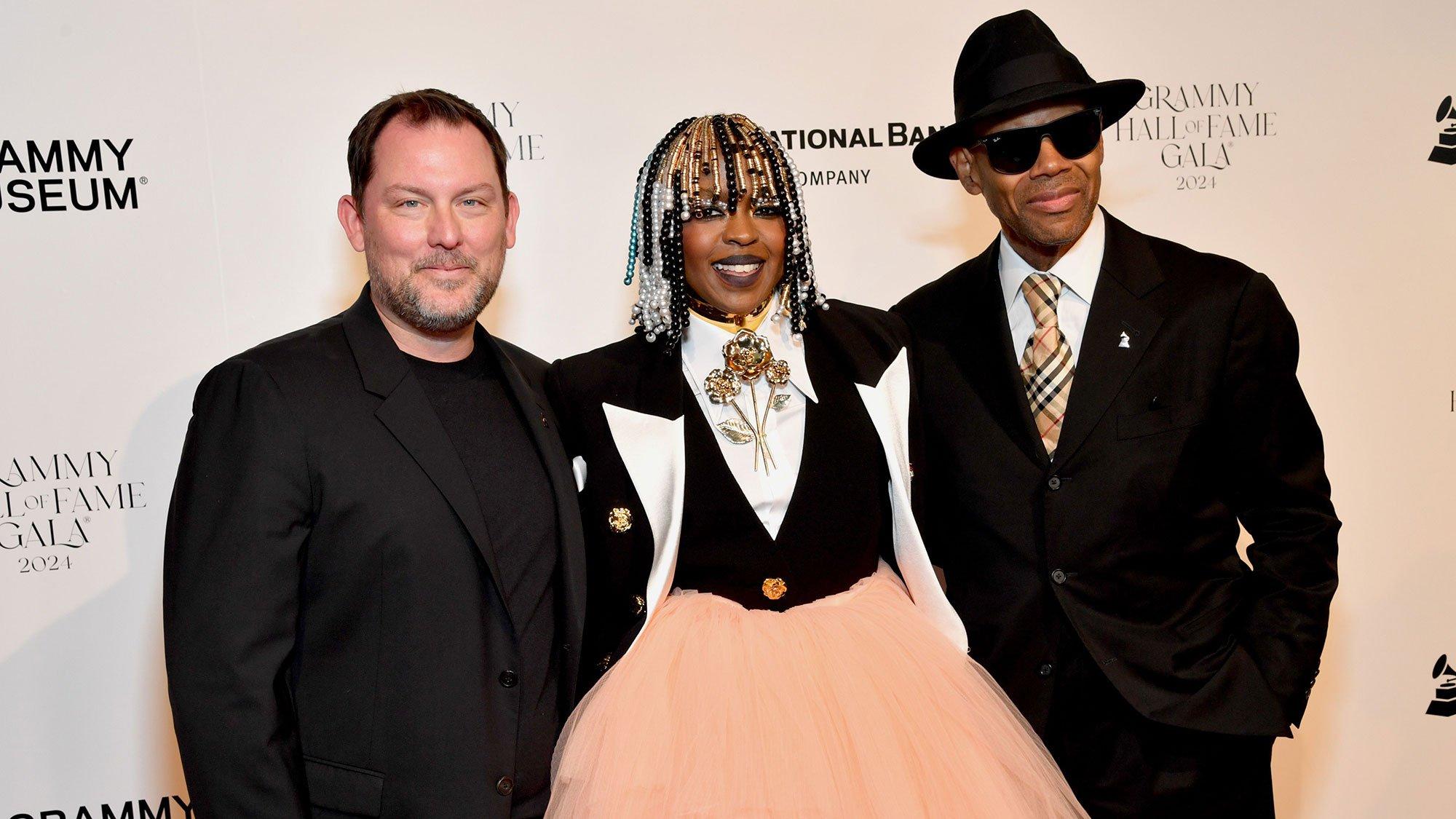
Photo: Sarah Morris/Getty Images for The Recording Academy
list
6 Key Highlights From The Inaugural GRAMMY Hall of Fame Gala Honoring Lauryn Hill, Donna Summer, Atlantic Records & Many More
The Recording Academy and GRAMMY Museum celebrated music's legacy with tributes to Charley Pride, Wanda Jackson, Buena Vista Social Club, and more, featuring performances by Andra Day, The War and Treaty, and other musical greats.
Many years ago, veteran CBS journalist Anthony Mason lost his entire record collection when it disappeared in transit as he moved from one place to another. Mason was inconsolable, and you could still hear a tinge of sadness in his voice when he recounted this painful story at the inaugural GRAMMY Hall of Fame Gala, held on May 21 at the Novo Theater in Los Angeles. The evening’s eloquent and entertaining host, Mason was making a point with his personal anecdote of lost records: music is priceless, one of our most treasured possessions — both as individuals and as a community. Preserving its legacy is essential.
It’s been over 50 years since the GRAMMY Hall of Fame was established by the Recording Academy's National Trustees to honor records of deep historical significance that are at least 25 years old. This year, the Recording Academy and the GRAMMY Museum paid tribute to 10 newly inducted recordings (four albums and six singles) by artists including De La Soul, Lauryn Hill, Buena Vista Social Club, Donna Summer, Guns 'N Roses, Charley Pride, Kid Ory’s Creole Orchestra, the Doobie Brothers, William Bell, Wanda Jackson, and Atlantic Records, the annual Gala's inaugural label honoree.
The first Hall of Fame Gala was a dazzling event presented by City National Bank, complete with guest speakers and performances by Andra Day, The War and Treaty, William Bell, Elle King, and HANSON covering some of the inducted works. The event underscored the sumptuous variety that continues to define popular music, spanning the sounds of hip-hop, rock, country, R&B, disco, and even the venerable Cuban dance music of decades past.
Here are six takeaway points from an evening marked by celebration and transcendent musical memories.
Donna Summer’s “I Feel Love” Has Lost None Of Its Edge
Studious music fans are well aware that “I Feel Love” — written by Donna Summer with visionary Italian producer Giorgio Moroder and British songwriter Pete Bellotte — is a shimmering disco gem, a futuristic precursor to the entire EDM genre. What was stunning about the Gala performance of the track by singer and actress Andra Day is how edgy and fresh the 1977 track still sounds today. Day’s ethereal reading was appropriately hypnotic, with live drums, nebulous synth textures and glorious, three-part vocal harmonies.
The Future Of American Music Is In Good Hands With The War and Treaty
Formed by husband and wife Michael Trotter Jr. and Tanya Trotter, The War and Treaty were rightfully nominated for Best New Artist at the 2024 GRAMMYs earlier this year. The duo’s electrifying combination of Americana, gospel, and rock is especially effective on a live stage, and the pair delivered a memorable rendition of Charley Pride's inducted Hall Of Fame country hit, “Kiss an Angel Good Mornin’,” recorded in 1971. The War and Treaty also received a standing ovation later in the evening for their performance of Ray Charles' classic, "What'd I Say," released in 1959.
26 Years Later, The Miseducation of Lauryn Hill Is Still Ahead Of Its Time
Released in August 1998, The Miseducation of Lauryn Hill sold more than 10 million copies in the U.S. alone, and became the first hip-hop artist to win Album Of The Year at the 1999 GRAMMYs. At the Gala, Andra Day delighted the audience — including Lauryn Hill and her family — with a soulful version of hidden track “Can’t Take My Eyes Off You,” originally a Frankie Valli hit from 1967. Day's performance was marked by brassy accents and funky bass lines, creating an unapologetically lush rendition that mirrored the sonic richness of Hill's original take.
Atlantic Records Transformed The Face Of Global Culture
Celebrating 75 years of inaugural label honoree Atlantic Records in the span of a few minutes loomed like an impossible task, but the Gala producers paid tribute to the legacy label well. Beginning with a short video, the event segment highlighted the miraculous roster assembled by Ahmet Ertegun and Herb Abramson that included Ray Charles, Aretha Franklin, Led Zeppelin, ABBA, Phil Collins, and Bruno Mars — to name just a few. But it was the actual performances that highlighted the label’s hold on pop culture: Ravyn Lenae’s breathy take on Roberta Flack’s “Killing Me Softly With His Song” made a case for considering the 1973 hit as one of the most vulnerable recordings of all time. On the other side of the dynamic spectrum, the epic rendition of Led Zeppelin’s “Stairway to Heaven” by alt-rock quartet Shinedown was appropriately intense.
The Wondrous Legacy Of Stax Records Should Not Be Underestimated
The home of such legendary artists as Otis Redding, The Staple Singers and Carla Thomas, Memphis-based Stax Records developed a rich, ragged sound with gospel, blues, R&B and luminous pop as its foundational pillars. Currently the subject of an HBO documentary series, "Stax: Soulsville USA," the record label defined American music during the ‘60s and ‘70s. Memphis singer/songwriter William Bell was one of its most prolific artists, and he regaled guests with a performance of his Hall of Fame inducted debut 1961 single, “You Don’t Miss Your Water.” At 84 years of age — and the winner of a Best Americana Album at the 2017 GRAMMYs — Bell was in rare form, and the band backed him up seamlessly, reproducing the sinuous organ lines of the original.
Read more: 1968: A Year Of Change For The World, Memphis & Stax Records
Future Editions Of The Gala Will Continue To Surprise And Delight
The inaugural GRAMMY Hall of Fame Gala set a high standard for future celebrations of iconic recordings. The event proved to be fertile ground for the creation of indelible music moments, showcasing the beauty and authority of music across genres and generations. Other honored Hall of Fame inducted recordings including De La Soul’s 3 Feet High And Rising, Guns’N’Roses Appetite For Destruction, the Buena Vista Social Club’s debut, Wanda Jackson’s “Let’s Have A Party,” Kid Ory’s Creole Orchestra’s “Ory’s Creole Trombone” and The Doobie Brothers’ “What A Fool Believes.”
As we look ahead, the excitement for future Galas grows, with each event promising to honor more historic recordings, and uphold the tradition of celebrating excellence in music's rich legacy.
Explore The 2024 GRAMMY Hall Of Fame Inductees
Revisiting 'The Miseducation Of Lauryn Hill': Why The Multiple GRAMMY-Winning Record Is Still Everything 25 Years Later
Remembering De La Soul’s David Jolicoeur, a.k.a. Dave and Trugoy the Dove: 5 Essential Tracks
Guns N' Roses 'Appetite For Destruction' | For The Record
An Ode To Donna Summer's 1970s: How The Disco Queen Embodied Both Innovator And Vixen
Essential Hip-Hop Releases From The 1980s: Slick Rick, RUN-D.M.C., De La Soul & More
For Charley Pride, Black Country Music Was A Self-Evident Truth
Beyoncé To Alison Krauss: 10 Times Women Made GRAMMY History
Love To Love Them, Baby: From Donna Summer To Dua Lipa, Meet The Women Singers Who Shaped (And Continue to Shape) Dance Music
10 Albums That Showcase The Deep Connection Between Hip-Hop And Jazz: De La Soul, A Tribe Called Quest, Kendrick Lamar & More
'The Miseducation Of Lauryn Hill': 25 Facts About The Iconic Album, From Its Cover To Its Controversy

Watch Kenny Loggins And Michael McDonald Take Home A GRAMMY For Song Of The Year For "What A Fool Believes" | GRAMMY Rewind
A History Of Casablanca Records In 10 Songs, From Kiss To Donna Summer To Lindsay Lohan
1968: A Year Of Change For The World, Memphis & Stax Records

Lauryn Hill's 'The Miseducation Of Lauryn Hill' | For The Record
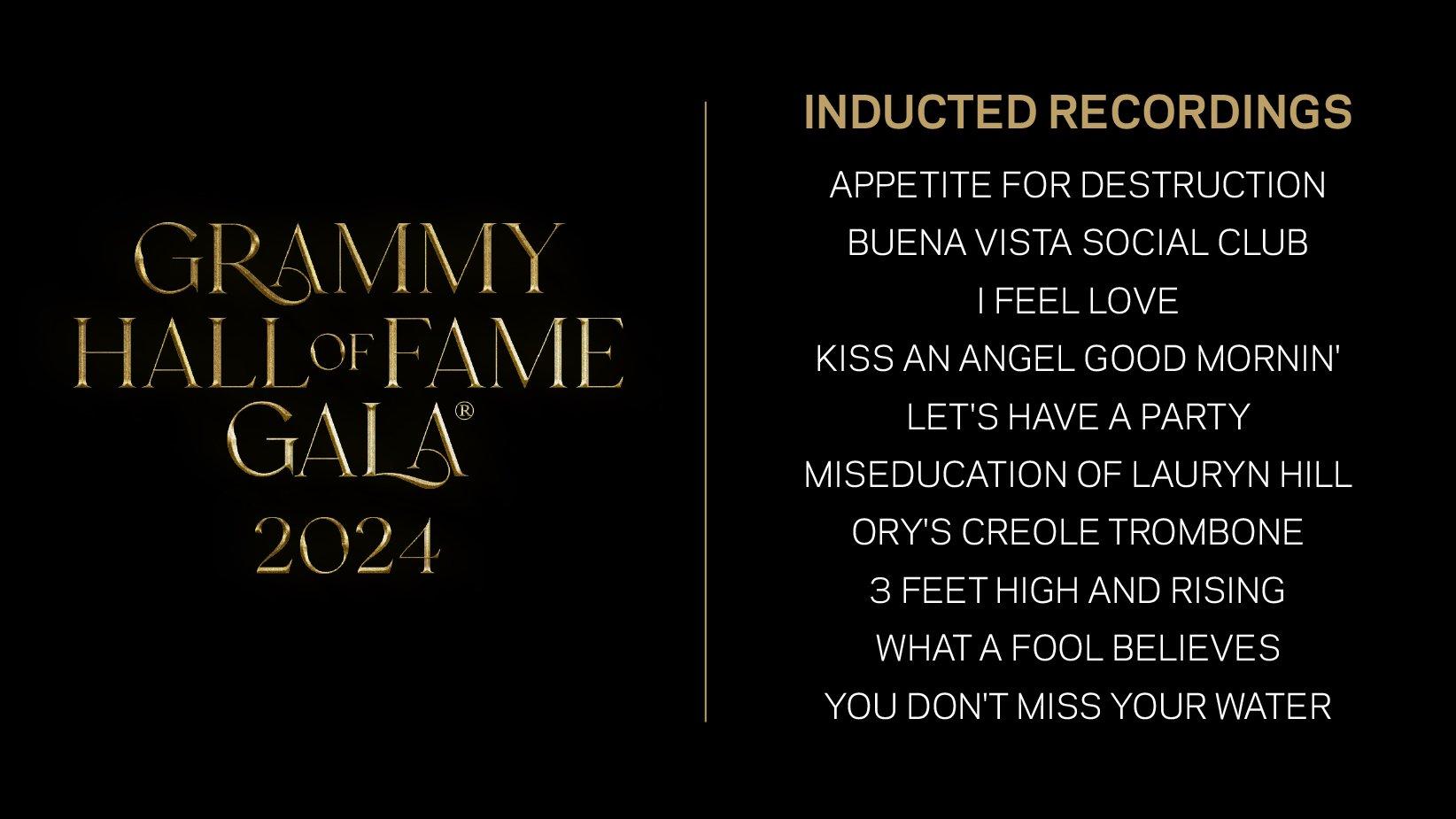
Image courtesy of the GRAMMY Museum
list
Explore The 2024 GRAMMY Hall Of Fame Inducted Recordings: Lauryn Hill, Guns N' Roses, De La Soul, Donna Summer & Many More
Learn more about the 2024 GRAMMY Hall of Fame inducted recordings, including iconic works by Buena Vista Social Club, Charley Pride, Wanda Jackson, and more. The inaugural GRAMMY Hall of Fame Gala takes place May 21 at the Novo Theater in Los Angeles.
As the GRAMMY Hall of Fame celebrates its 50th anniversary, the Recording Academy and GRAMMY Museum are proud to honor the 2024 inductees with the inaugural GRAMMY Hall of Fame Gala, presented by City National Bank, taking place Tuesday, May 21, at the Novo Theater in Los Angeles. This year, the GRAMMY Hall of Fame will induct 10 recordings: four albums and six singles.
This year's class of inductees highlights the diversity and historical significance of recordings that have shaped the musical landscape. From Lauryn Hill's groundbreaking album The Miseducation of Lauryn Hill to the electrifying Appetite For Destruction by Guns N' Roses, the selected recordings span genres and eras and showcase the lasting impact of these timeless works. Other notable inductees include De La Soul's 3 Feet High and Rising, Buena Vista Social Club's self-titled album, and singles by Donna Summer, Charley Pride, Wanda Jackson, Kid Ory's Creole Orchestra, the Doobie Brothers, and William Bell.
The GRAMMY Hall Of Fame Gala promises an unforgettable night, featuring performances that pay tribute to the newly inducted recordings. Artists such as Andra Day, William Bell, Elle King, and HANSON will bring these iconic songs to life while celebrating the rich heritage of the music honored this year. Hosted by veteran CBS journalist Anthony Mason, the evening will also recognize the contributions of Atlantic Records and feature an online auction benefiting the GRAMMY Museum.
The GRAMMY Hall Of Fame was established by the Recording Academy's National Trustees in 1973 to honor recordings of lasting qualitative or historical significance that are at least 25 years old. The inducted recordings are selected annually by a special member committee of eminent and knowledgeable professionals from all branches of the recording arts with final ratification by the Recording Academy's National Board of Trustees. There are currently 1,152 inducted recordings in the GRAMMY Hall Of Fame. Explore the full list of all the GRAMMY Hall Of Fame inducted recordings.
Join us as we honor the 2024 GRAMMY Hall of Fame inductees and celebrate the recordings that continue to resonate with listeners around the world by exploring the newly inducted works in depth below.
Tickets for the inaugural GRAMMY Hall of Fame Gala are available now.
Explore The 2024 GRAMMY Hall Of Fame Inductees
Revisiting 'The Miseducation Of Lauryn Hill': Why The Multiple GRAMMY-Winning Record Is Still Everything 25 Years Later
Remembering De La Soul’s David Jolicoeur, a.k.a. Dave and Trugoy the Dove: 5 Essential Tracks
Guns N' Roses 'Appetite For Destruction' | For The Record
An Ode To Donna Summer's 1970s: How The Disco Queen Embodied Both Innovator And Vixen
Essential Hip-Hop Releases From The 1980s: Slick Rick, RUN-D.M.C., De La Soul & More
For Charley Pride, Black Country Music Was A Self-Evident Truth
Beyoncé To Alison Krauss: 10 Times Women Made GRAMMY History
Love To Love Them, Baby: From Donna Summer To Dua Lipa, Meet The Women Singers Who Shaped (And Continue to Shape) Dance Music
10 Albums That Showcase The Deep Connection Between Hip-Hop And Jazz: De La Soul, A Tribe Called Quest, Kendrick Lamar & More
'The Miseducation Of Lauryn Hill': 25 Facts About The Iconic Album, From Its Cover To Its Controversy

Watch Kenny Loggins And Michael McDonald Take Home A GRAMMY For Song Of The Year For "What A Fool Believes" | GRAMMY Rewind
A History Of Casablanca Records In 10 Songs, From Kiss To Donna Summer To Lindsay Lohan
1968: A Year Of Change For The World, Memphis & Stax Records

Lauryn Hill's 'The Miseducation Of Lauryn Hill' | For The Record
De La Soul, 3 Feet High And Rising
Tommy Boy Records, 1989
Celebrating its 35th anniversary in 2024, 3 Feet High and Rising is the debut studio album from Long Island, New York-born hip-hop trio De La Soul. Released on Tommy Boy Records in 1989 — considered one of the years during hip-hop’s "Golden Age" — and produced by legendary DJ and hip-hop producer Prince Paul, the album was a critical and commercial success. Featuring samples that draw on a vast array of genres — from doo-wop and psychedelic rock to children’s music — the album was unlike any hip-hop album that came before it. Melding inventive production with clever and humorous wordplay and samples from artists as diverse as Johnny Cash (the title of the album is derived from the Cash song "Five Feet High and Rising"), Hall & Oates, Steely Dan, and the Turtles, 3 Feet High And Rising is often considered the beginning of 1990s alternative hip-hop. De La Soul’s use of skits/comedy sketches as interludes also had a huge influence on future generations of rappers. In a review of the album for The Village Voice in 1989, music critic Robert Christgau wrote, "An inevitable development in the class history of rap, [De La Soul is] new wave to Public Enemy’s punk."
Featuring the singles "The Magic Number," "Buddy," "Eye Know," and the GRAMMY-nominated "Me Myself and I," 3 Feet High and Rising spent five weeks at No. 1 on the Billboard Top R&B/Hip-Hop Albums chart. "Buddy" is one of the album’s hallmark songs and features cameos from Q-Tip, Phife Dawg, Jungle Brothers, Queen Latifah, and Monie Love — who are collectively known as the Native Tongues (along with Black Sheep, the Beatnuts and Chi Ali).
The platinum-certified record consistently places on lists of the greatest albums of all time, including in 2023 when Paste magazine featured it at No. 4 on their list of the Greatest Debut Albums of the 1980s. In 2010 it was selected by the Library of Congress for preservation in the National Recording Registry. 3 Feet High and Rising has influenced countless artists, from the Roots and Yasiin Bey to OutKast and Common. With the album's undeniably trailblazing release, Posdnuos, Trugoy the Dove and Pasemaster Mase of De La Soul have cemented themselves as one of the best rap groups of all time.
Kelvin "Posdnuos" Mercer – Artist/Songwriter
David "Trugoy the Dove" Jolicoeur – Artist/Songwriter
Vincent "Maseo" Mason – Artist/Songwriter
"Prince Paul" Huston – Producer/Engineer/Songwriter
Alan Watts – Engineer/Mixer
Guns N’ Roses, Appetite For Destruction
Geffen, 1987
Guns N’ Roses’ Appetite For Destruction LP will go down in history as one of the most iconic and influential rock albums ever made. But when it was released in the summer of 1987, Appetite didn’t initially garner much mainstream attention. Once the band hit the road in support of the album, singles "Welcome to the Jungle", "Paradise City" and "Sweet Child O' Mine" started getting significant airplay. By the summer of 1988, the band found themselves with a No. 1 album on the Billboard 200. Appetite For Destruction became the best-selling album of all time in the U.S. and the best-selling debut album. In a review for Pitchfork, Maura Johnston said, "The debut from Guns N' Roses was a watershed moment in '80s rock that chronicled every vice of Los Angeles led by the lye-voiced Axl Rose and a legendary, switchblade-sharp band."
Produced by Mike Clink, Appetite for Destruction is widely considered a near perfect album where the deep cuts are just as good as the hits. From the opening roar of "Welcome to the Jungle" and the iconic "Sweet Child O’ Mine," to "It's So Easy," "Nightrain," "You're Crazy," and "Mr. Brownstone," the album is an artistic triumph in sound, songwriting and production, earning its place at No. 62 on Rolling Stone’s list of the 500 Greatest Albums of All Time. In many ways, the album changed the world. In a 2018 article for Revolver, Dan Epstein noted that Appetite ushered in a new wave of bands like the Black Crowes with its "blues-based music played by an unflashy yet hard-swinging rhythm section, a rock-solid rhythm guitarist, a flashy-but-soulful lead player and a charismatic vocalist who exuded danger and decadence." It also paved the way for Nirvana and the arrival of grunge as rock fans’ "ears were primed for more raw, real and rebellious hard rock." Now, nearly 40 years since its release, Appetite for Destruction has sold over 30 million copies worldwide and is without a doubt one of the most successful debut albums of all time.
Axl Rose – Artist/Songwriter
Slash – Artist/Songwriter
Duff McKagan – Artist/Songwriter
Steven Adler – Artist/Songwriter
Izzy Stradlin – Artist/Songwriter
Mike Clink – Engineer/Producer
Steve Thompson – Mixer
Buena Vista Social Club, Buena Vista Social Club
World Circuit/Nonesuch, 1997
In 1996, a group of veteran Cuban musicians was assembled to record an album that would pay tribute to Cuba’s "musical golden age" of the 1930s to 1950s. Showcasing styles of music that were popular at the time, such as son, bolero and danzón, the group became known as the Buena Vista Social Club, named after a 1940s-era members-only music club that was located in the Buenavista quarter of Havana. Organized by British music producer and executive Nick Gold and produced by GRAMMY-winning American guitarist Ry Cooder and Cuban director Juan de Marcos Gonzalez, Buena Vista Social Club recorded their eponymous 14-track debut album in just six days. Released in September 1997, the album featured 20 of Cuba’s most prominent musicians, including vocalist Ibrahim Ferrer (1927–2005), pianist Rubén González (1919–2003), and vocalist/guitarist Compay Segundo (1907–2003). Buena Vista Social Club was an instant hit with tracks such as the four-chord song "Chan Chan," written by Segundo, and a rendition of the romantic criolla "La Bayamesa." Everything fell into place at the right time for this album — from the chemistry between the musicians to the rich music history of Havana — to create one of the moments that can only be described as pure musical magic. Buena Vista Social Club sold more than 1 million copies, earned a spot on the Billboard 200, and won the GRAMMY Award for Best Tropical Latin Performance.
In 1998 the ensemble held performances in Amsterdam and New York that were captured on film by German director Wim Wenders. Along with interviews with musicians that were conducted in Havana, a documentary, titled Buena Vista Social Club, was released in 1999 and earned an Oscar nomination for Best Documentary (Feature). In 2003, Buena Vista Social Club was named on Rolling Stone’s list of the 500 Greatest Albums of All Time, and in 2022, it was selected by the Library of Congress for preservation in the National Recording Registry. Further cementing its place in the music history books, Buena Vista Social Club was recognized by Guinness World Records as the best-selling album of world music with more than 8 million copies sold worldwide.
Ry Cooder – Leader/Producer
Juan Demarcos Gonzalez – Director
Larry Hirsch – Engineer
Jerry Boys – Engineer/Mixer
Donna Summer, "I Feel Love"
Casablanca, 1977
When the Queen of Disco, Donna Summer, released her hit single "I Feel Love" in 1977, it propelled Brian Eno (who was in the studio with David Bowie at the time) to rush in and declare, "This single is going to change the sound of club music for the next 15 years." Now, more than 40 years after its release, "I Feel Love" definitely changed something – it changed pop music forever. Recorded with producers Giorgio Moroder and Pete Bellotte, the goal was to create a song that signified the future — and it did. "I Feel Love" was the first song to pair repetitive synthesizer loops with four-on the-floor bass drum and an off-beat hi-hat, helping to forge the path for synth pop, New Romantics, Italo disco, Hi-NRG, electro, house, techno, and more. Along the way, the global smash influenced countless artists, including Blondie, who became one of the first punk-associated groups to embrace disco, releasing "Heart of Glass" the following year.
Upon its release, "I Feel Love" reached No. 1 in several countries, including the UK, and peaked in the Top 10 on the Billboard 200. In 2012, the Library of Congress selected it for preservation in the National Recording Registry. Many of today’s biggest artists have paid tribute to Summer’s groundbreaking track with covers or samples, including Madonna, Red Hot Chili Peppers, Bronski Beat, and Beyoncé, the latter of whom samples "I Feel Love" on "Summer Renaissance," the closing track on her 2022 GRAMMY-winning album Renaissance. To this day, "I Feel Love" is considered the No. 1 greatest dance song of all time (Rolling Stone).
The song's impact on the LGBTQ+ community is equally as great as its impact on the dance community. GRAMMY-winning artist Sam Smith, who released a cover of "I Feel Love" in 2019, wrote on X: "As a queer person, ‘I Feel Love’ has followed me to every dance floor in every queer space from the minute I started clubbing. This song, to me, is an anthem of our community." In 2023, Pride Life Global ranked the track as one of the best gay anthems.
Donna Summer – Artist/Songwriter
Giorgio Moroder – Producer/Songwriter
Pete Bellotte – Producer/Songwriter
Jürgen Koppers – Artist/Songwriter
Charley Pride, "Kiss An Angel Good Mornin'"
RCA Victor, 1971
"Kiss An Angel Good Mornin’" is GRAMMY winner Charley Pride’s biggest hit of his career. Released in 1971 as the first single from his GRAMMY-winning album Charley Pride Sings Heart Songs, the song peaked at No. 21 on the Billboard Hot 100, his only single to break the Top 40. Considered one of Pride’s signature songs, the track marked his eighth single to top the Billboard Hot Country Songs chart and became one of the biggest country hits of the decade. "Kiss An Angel Good Mornin’" was produced by Cowboy Jack Clement (Waylon Jennings, Willie Nelson, Dolly Parton) and written by Ben Peters, who got the inspiration for the song after he and his wife Jackie welcomed their daughter Angela. It’s a song purely about love and a slight departure from Pride’s other hits, such as "I’m Just Me" and "I’d Rather Love You." In a 2021 article for CMT, Marcus K. Dowling writes, "The achievement of conveying life's simple joys with a magnificent voice over complex countrypolitan rhythms and melodies — instead of discussing complex emotions over those same types of tracks — is the greatest victory of Pride's signature song." The single also earned Pride a GRAMMY nomination for Best Country Vocal Performance, Male. Since its release, "Kiss An Angel Good Mornin’" has been covered by countless artists, including George Jones, Conway Twitty, Gene Stuart, and Roy Clark — all of whom released the song in 1972 — along with Percy Sledge, Alan Jackson and Heather Myles.
When he signed with RCA in 1964, Pride became the first Black country music singer to get a major record label deal. He went on to have 29 No. 1 hits on the Billboard Hot Country Songs chart, selling more than 70 million records. When it comes to sales for RCA, he is second only to Elvis Presley. Though he passed away in December 2020, Pride’s impact on country music, especially Black country music artists, remains. His influence can be heard in the music of up-and-coming artists such as Brittney Spencer, Mickey Guyton and Shy Carter. As country music’s first Black superstar, Pride and his warm baritone captivated audiences, broke racial and cultural barriers, and earned him an induction into the Grand Ole Opry in 1993.
Charley Pride – Artist
Jack Clement – Producer
Ben Peters – Songwriter
Ray Butts – Artist
Mike Shockley – Producer
Wanda Jackson, "Let's Have A Party"
Capitol, 1960
Originally recorded by Elvis Presley for the 1957 musical/romance film Loving You, "Let’s Have a Party" was recorded by Wanda Jackson and released on her eponymous debut album in 1958. After Jackson’s version of "Let’s Have a Party" was discovered by an Iowa disc jockey and received an increase in interest from radio listeners, Capitol Records encouraged Jackson to release the song as a single two years later in 1960. The song became a hit, making the Top 40 in the U.S. and topping the chart in the U.K. The success of "Let’s Have a Party" inspired Jackson to rename her band the Party Timers and Capitol subsequently released the compilation album, Rockin’ With Wanda that same year. As one of the first women to have a career in rock and roll, Jackson recorded a series of singles in the 1950s that helped earn her the nickname of The Queen of Rockabilly. It was Elvis, with whom she toured with in 1955, who encouraged her to record in the rockabilly style.
In 2005, Jackson received the Fellowship Award from the National Endowment for the Arts, becoming the first female country and rock artist to receive the honor. In 2009, after several artists advocated on her behalf — including Elvis Costello, Bruce Springsteen and Cyndi Lauper — Jackson was inducted into the Rock and Roll Hall of Fame. Lauper has cited Jackson as one of her earliest influences, recording a cover of "Funnel of Love" for her 2016 album Detour. Other artists who have listed Jackson as an influence include Adele and Elle King.
Lauper told Rolling Stone in 2016: "I think for country you look at Patsy Cline or Loretta Lynn who played a guitar, or sang the songs she wrote, and Dolly Parton. But Wanda Jackson was a rocker, and so, of course, I was going to listen and learn from her because I was a rocker and that's what we did."
Jackson is also a member of the Rockabilly Hall of Fame, the Iowa Rock and Roll Hall of Fame, the Oklahoma Hall of Fame, and the Oklahoma Country Music Hall of Fame. In 2010, she was the recipient of the Lifetime Achievement Award from the Americana Music Honors.
Wanda Jackson – Artist
Ken Nelson – Producer/Engineer
Jesse Mae Robinson – Songwriter
Kid Ory’s Creole Orchestra (As Spike’s Seven Pods Of Pepper Orchestra), "Ory's Creole Trombone"
Nordskog, 1922
Louisiana-born composer, trombonist and bandleader Edward "Kid" Ory put New Orleans jazz on the map. Kid Ory’s 1922 hit "Ory’s Creole Trombone" was the first recording of Black/Creole New Orleans jazz. Recorded in Los Angeles, the single features Ory on trombone, along with Thomas "Papa Mutt" Carey on cornet, Oliver "Dink" Johnson on clarinet, Fred Washington on piano, Ed "Montudie" Garland on bass, and Ben Borders on drums. Upon release, the entire first pressing of 5,000 records sold out, leading to gigs for Ory and his band down the California coast in San Diego and Tijuana.
Born on Christmas Day in LaPlace, Louisiana, Ory led a band early on in his career in New Orleans that featured music legends such as Joe "King" Oliver, Johnny Dodds, Johnny St. Cyr and, later, Louis Armstrong. Ory relocated to Los Angeles after the prohibition of alcohol in 1919 changed the landscape for jazz musicians performing in New Orleans nightclubs. Many of the musicians who played on his L.A. sessions had also recently relocated from New Orleans. After moving to Chicago in 1925, where jazz was just starting to gain traction, Ory worked and recorded with artists such as Armstrong, Jelly Roll Morton, Bessie Smith, Ma Rainey, and many others. He was an original member of Louis Armstrong and His Hot Five, with whom he would later re-record "Ory’s Creole Trombone" in 1927. As demonstrated on "Ory's Creole Trombone," Ory was an early adapter of the glissando technique, now a central element of New Orleans jazz. While he might not have been the first to play a glissando on a trombone, he was certainly the most influential.
In 2005, "Ory’s Creole Trombone" was selected by the Library of Congress for preservation in the National Recording Registry. In an essay written upon the recording's selection by the Library of Congress, GRAMMY-nominated musician and jazz historian David Sager wrote, "‘Ory’s Creole Trombone’ offers a rare glimpse into the origins of New Orleans jazz and a remarkable insight to this music’s durability and universal appeal." A pioneering record and one of the most essential jazz recordings, "Ory’s Creole Trombone" helped define the New Orleans style of jazz and served as the prototype for future musicians of that genre.
Edward "Kid" Ory – Artist/Songwriter
Lauryn Hill, The Miseducation Of Lauryn Hill
Ruffhouse Records / Columbia Records, 1998
Widely considered one of the greatest albums of all time, The Miseducation of Lauryn Hill is the debut album and only solo studio set released by GRAMMY-winning singer and rapper Lauryn Hill. The album debuted at No. 1 on the Billboard 200 and sold more than 422,000 copies in its first week, breaking the record for first-week sales by a female artist. Credited for bringing hip-hop and neo-soul to the forefront of popular music, the album earned Hill 10 GRAMMY nominations, which now has her tied with Beyoncé for the Guinness World Record for most GRAMMY nominations in a single year for a female artist. Hill turned half of those nominations into wins, taking home the awards for Album Of The Year, Best New Artist, Best R&B Album, and Best Rhythm & Blues Song and Best Female R&B Vocal Performance for "Doo Wop (That Thing)." With lyrics that present arguably the most poignant of female perspectives on life, love and relationships, while also touching on the turmoil within her former group the Fugees, three of the album’s singles — "Everything Is Everything, "Ex-Factor" and "Doo Wop (That Thing)" — peaked in the Top 40 on the Billboard 200, with the latter claiming the top spot.
The Miseducation of Lauryn Hill was partially recorded at Bob Marley’s studio Tuff Gong Studios in Kingston, Jamaica, while Hill was pregnant with her first son, Zion. Speaking about that time, Hill told Rolling Stone, "When some women are pregnant, their hair and their nails grow, but for me it was my mind and ability to create. I had the desire to write in a capacity that I hadn't done in a while. I don't know if it's a hormonal or emotional thing ... I was very in touch with my feelings at the time." The album’s track "To Zion," which features Carlos Santana on guitar, is a song about her son.
In 1999, Hill became the first hip-hop artist to appear on the cover of TIME magazine. Now, more than 25 years since its release and with more than 20 million copies sold, The Miseducation of Lauryn Hill continues to be one of the most influential albums ever made.
Lauryn Hill – Artist/Producer/Songwriter
Gordon "Commissioner Gordon" Williams – Engineer
Tony Prendatt – Engineer
The Doobie Brothers, "What A Fool Believes"
Warner Bros. Records, 1978
One of the few non-disco songs to hit No. 1 on the Billboard Hot 100 in 1979, the Doobie Brothers’ "What a Fool Believes" is featured on their 1978 eighth studio album, the Album Of The Year-nominated Minute by Minute. Co-written by Michael McDonald and Kenny Loggins, "What a Fool Believes" won the Doobie Brothers two GRAMMY Awards, including Record Of The Year. Stylistically speaking, the song is unlike anything the Doobie Brothers had done before.
"What a Fool Believes" started off as a piano piece idea McDonald had. Producer Ted Templeman heard what he was working on and encouraged him to put some lyrics down with a co-writer. It turns out that McDonald and Loggins had talked about working together for some time. When they got together at McDonald’s house in Los Angeles to write, Loggins had already come up with the song’s hook — "she had a place in his life." Telling the story of a man who attempts to rekindle a romantic relationship, "What a Fool Believes" is about the lies we sometimes tell ourselves about past romances. When the protagonist in the song attempts to reconnect with an old love, he realizes that he barely registers in the woman’s mind. The Doobie Brothers and Templeman recorded numerous takes of its rhythm track over five or six days, but they couldn’t land on a version they all liked. Templeman eventually decided to cut up the master tape of a recording into sections. "In those days when you cut the tape, you’re over – that’s the master of your recording," recalled Templeman in an interview with The Guardian in 2022. "But we got lucky and I put it together on the spot." McDonald completed the rest of the arrangement, adding keyboards, vocals and strings. Before it was released by the Doobie Brothers, Loggins released his own jazzier and experimental version of the song on his 1978 album Nightwatch.
"What a Fool Believes" was rated as the Doobie Brothers’ all-time greatest song by Ultimate Classic Rock critic Michael Gallucci and listed on Rolling Stone’s Top 500 Greatest Songs of All Time list. Today, "What a Fool Believes" is considered a "foundational yacht rock classic," as Tom Breihan wrote in a review for Stereogum in 2020. Jeff "Skunk" Baxter – Artist
John Hartman – Artist
Keith Knudsen – Artist
Michael McDonald – Artist/Songwriter
Tiran Porter – Artist
Patrick Simmons – Artist
Ted Templeman – Producer
Kenny Loggins – Songwriter
Donn Lander – Engineer
William Bell, "You Don’t Miss Your Water"
Stax Records, 1961
As the first male solo act signed to the legendary Stax Records, Memphis-born GRAMMY-winning singer/songwriter William Bell released his solo debut with the melancholy "You Don’t Miss Your Water" in 1961. Recorded as a demo with members of the Mar-Keys and MG’s, "You Don’t Miss Your Water" was originally released as a B-side of his single "Formula of Love" and gained steam after DJs flipped the record over and started playing "You Don’t Miss Your Water." The song became the first hit for Stax Records, charting on the Billboard Hot 100 in 1962. It was later released on Bell’s 1967 album The Soul of a Bell and remains his best-known recording to this day.
"The message is universal: appreciate what you have," said Bell in a 2022 interview with Uncut magazine. "Back then I didn’t realize what I was writing, but after I got a little older, I realized that although the world changes physically, every generation has the same wishes, desires and aspirations. If you just write truthfully about life and write things you think will help people, it will resonate."
And indeed, the song did resonate. More than six decades since its release, "You Don’t Miss Your Water" has gone on to become a Southern classic. Countless artists have recorded covers of it, including Otis Redding, Percy Sledge, Taj Mahal, Jerry Lee Lewis, the Black Crowes, Sturgill Simpson, Peter Tosh & the Wailers, Brian Eno, and, most notably, the Byrds, on their seminal 1968 country-rock album Sweetheart of the Rodeo.
In 2013, Bell performed "You Don’t Miss Your Water" before President Barack Obama during "In Performance at the White House: Memphis Soul." The following year, Bell was featured in the documentary Take Me to the River, reflecting upon American music's soul. He was inducted into the Memphis Music Hall of Fame in 2016. In 2020, the National Endowment for the Arts celebrated him as a Heritage Fellow. Bell was instrumental in ushering in the Southern soul music genre, which is now known as the globally influential "Memphis Sound."
William Bell – Artist/Songwriter
Chips Moman – Producer
